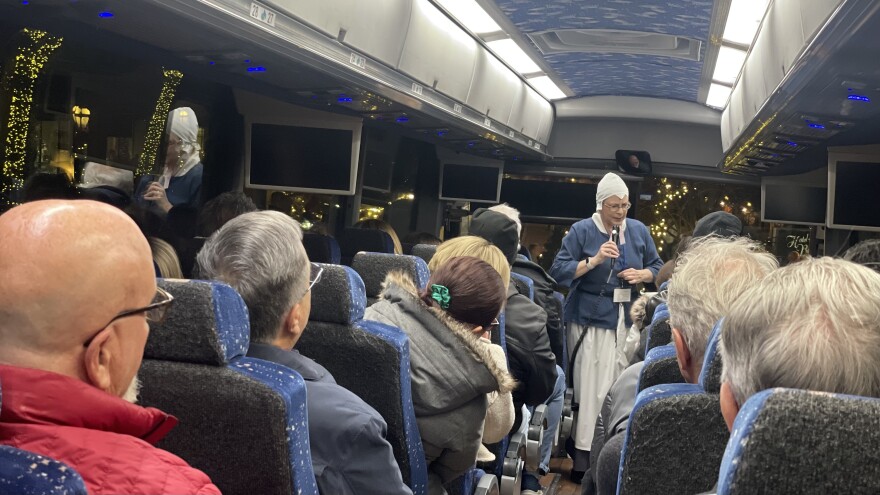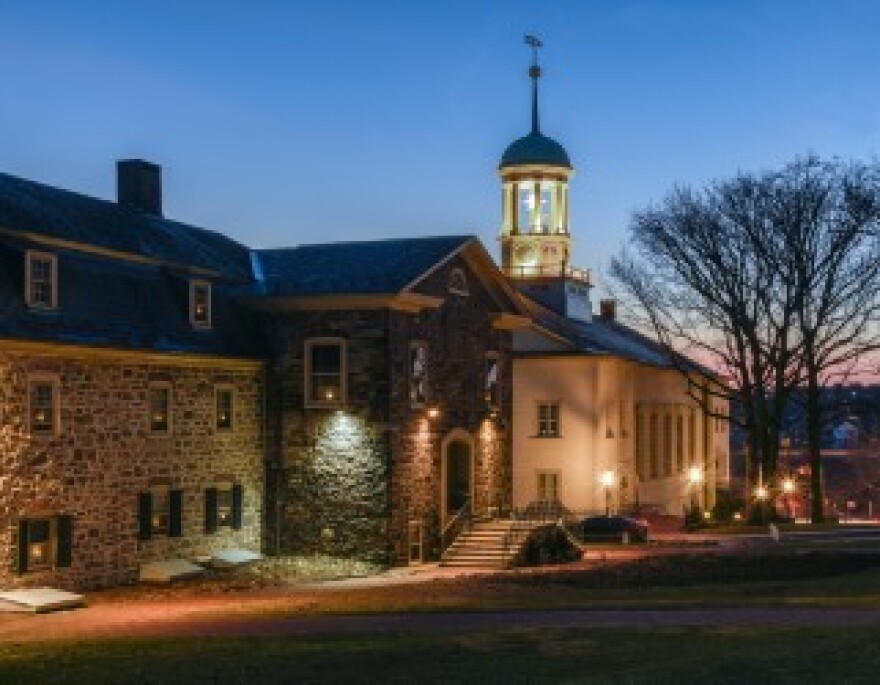Visit Us
Walk through history as we guide you to things to learn, places to discover, and events that help connect us to our rich heritage.
Christmas 2025 Tickets on Sale Now! Get the best deals of the year on our holiday programming! Purchase your tickets before July 31 to save. Buy now.
December 26th, 2024 | In The News
Written by Micaela Hood
BETHLEHEM, Pa. — All aboard a Christmas City ride jam-packed with historical tidbits and scherzi (or jokes in German).
Recently, my bestie and I were among about 50 passengers on the Bethlehem By Night motor coach tour — an hourlong excursion that tells the story of the founding of the city in the 1700s, and the rise, and eventual fall, of Bethlehem Steel.
The new attraction is part of the Historic Bethlehem Museums & Sites’ holiday lineup.
Other attractions include horse-drawn carriage rides, a live Advent calendar (with caroling), a Central Moravian Nativity scene, a Christmas tree exhibit and a holiday house tour.

The tour departs daily at 5, 6 and 7 p.m. and will operate through Jan. 31.
Our tour was on a busy Saturday with a departure time of 7 p.m.
Be prepared for delays: Next to Musikfest, Christmas is among the busiest times of the year in the region. People take the Christmas City aspect of Bethlehem seriously.
That night, vehicles on Main Street were at a standstill and the shops and restaurants were filled.
With no parking in sight, valet from Historic Hotel Bethlehem told us to park in the Lehigh lot (a free pass is given out to tour ticket holders). From there, you can walk up the hill or wait for a free shuttle ride.
The Historic Hotel Bethlehem, decked with festive halls and shiny trimmings, was equally packed with visitors and locals, who filled the hotel lobby.
The tour bus arrived right on time and we got in line with about 50 passengers.
We sat in the back, on the right side of the bus (I recommend sitting on the left; more on that later).
Our guide, Dawn Horvath, introduced herself and pointed to her outfit and bonnet, or more accurately, Schneppel Haube.
“We’re going to go through 280 years of history,” Horvath exclaimed as the bus’ air brakes started to hiss and its driver pulled off.
For the first five minutes of the trip, Horvath touched on the city’s new status as a UNESCO World Heritage Site, and the family dynamics of a traditional Moravian family.
Then, as the bus rode a loop around Main, Broad and Lehigh streets, she went on to tell the story of how the Moravians came to live here.
The short version is that after first settling in Georgia (around 1730), 14 Moravians moved north and struck up a kinship with an Episcopalian minister, George Whitfield.
Whitfield, Horvath said, offered the Moravians the opportunity to live on his land in Nazareth, but later kicked them out.
They bought 500 acres and first lived in a two-story building, now known as Hotel Bethlehem.
Fun fact No. 11: The Moravians named the town Bethlehem in 1741 during a Christmas Eve service and after singing a hymn with the lyrics, “lowly Bethlehem.”
The tour continued with a ride past City Center to Payrow Plaza.
Our guide pointed out the Christmas tree, the Nativity scene (or putz in German) and Mayor Willie J. Reynolds’ tree.

“The mayor’s tree is in the back with red, white and blue lights in honor of our service people,” Horvath said.
As with most of the stops, those sitting on the left side of the bus had a better view of city hall and the nearby Japanese tea house — a gift from Bethlehem’s sister city of Tondabayashi, Japan.
Fun fact No. 2: Bethlehem has six sister cities: Tondabayashi; Patillas, Puerto Rico; Schwäbisch Gmünd, Germany; Foiano di Val Fortore, Italy; Murska Sobota, Slovenia; and Corful, Greece.
The motor coach slowed down as we approached the buildings of East Church Street — home to the largest colonial Germanic architecture in the United States.
As Horvath shared facts about the historic houses, the bus stopped at the light on the corner.

“The Central Moravian Church was built between 1803 and 1806,” Horvath said. “When it was built, it could seat 1,500 people, which is really amazing because only 500 people lived in Bethlehem at the time.
“They knew if you build it, they would come.”
As the bus passed the Sun Inn, built in 1758, Horvath spoke about its famous guests, including President John Adams and the Marquis de Lafayette.
“John Adams also went to a Moravian church service, and he wrote home to [wife] Abigail, that the women looked like cabbage heads — must be the Schneppel Haube.
Next on the tour was a ride through West Bethlehem, then across the New Street Bridge into Southside Bethlehem.
“The South Side was originally all Moravian farmland,” Horvath said. “After they purchased that initial 500 acres, they kept purchasing more land, and ultimately had 4,000 acres between the two sides of town.
“By the mid-1800s, they needed some cash, so they started to sell off some land, and they sold it off to land capitalists, who in turn sold it to industrialists.
“You’ll see that the south side of Bethlehem definitely has more of a metropolitan industrial feel to it. And the Christmas trees on this side of town have colored lights…that’s intentional.
“On the north side of town, we celebrate that candlelight, so the light of the Moravian community. On the south side of town, we celebrate all of the people who came to Bethlehem to keep industry alive.”
The bus continued to pass the Cathedral Church of the Nativity and the Sayre and Wilbur mansions, where the industrialists lived.
“We’re going up a hill again, we do this a lot in Bethlehem,” Horvath said, jokingly, as the coach made its ascent.
Fun fact No. 3: The first industry on the South Side was not steel, but zinc, which came to the city in 1853.
As we in the motor coach rode up Route 378, toward South Mountain, I started to perk up.
The tour description mentions a ride “near” the Star of Bethlehem, but because of where we were sitting (again, back of the bus, on the right side) there wasn’t much to see.
Still, we learned some details on how it came to shine bright.

Fun fact No. 4: The star has been lit in Bethlehem every year since 1937, except during World War II, when it was considered a target for war planes. In 1991, when the city celebrated its 250th anniversary, officials decided to keep it lit year-round.
The last loop took us past the SteelStacks campus, where Horvath supplied bus riders with information about Bethlehem Steel, which closed for good in 2003.
Our last drive of the night ended with a ride on New Street, where the homes’ outsides showcase Moravian traditions.
“In the 1700s, if you were traveling at night, and you saw a candle lit in a window, you knew there was hospitality there,” Horvath said.
“And if you needed shelter for the evening, it was a safe place to be.”
Many homes there also place a Moravian star on the porch, typically as a light fixture.
Fun fact No. 5: The candles in the windows is a Moravian tradition that starts during the first Sunday of Advent until Epiphany Day in January.
Tickets for the ride cost $25 per person.
While it may not serve as the best opportunity for photo-opportunities, the experience is filled with historical facts about the Christmas City.
Also, the bus is heated, which is preferable to walking around in the cold.
For more information, visit Historic Bethlehem Museums & Sites.
Translate the Historic Bethlehem Museums & Sites website into your language of choice!